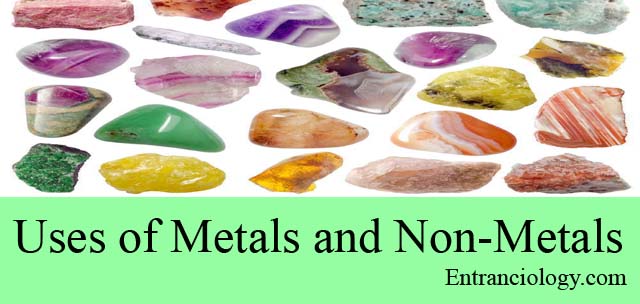
Definition of Metals : Metals are the elements that conduct heat and electricity, and are malleable and ductile. Metals are also lustrous (shiny), hard, strong, heavy and sonorous (which make ringing sound when struck).
Examples of Metals : Copper, Zinc, Calcium, Sodium, Gold, Silver Etc.
Definition of Non-Metals : Non-Metals are the elements that do not conduct heat and electricity, and are neither malleable nor ductile. Non-metals are brittle, and not lustrous (not shiny) i.e. they have dull appearance. They are generally soft, and not strong. Non-Metals are light substances and non-sonorous (means which do not make ringing sound when struck).
Examples of Non-Metals : Sulphur, Silicon, Oxygen, Iodine, Neon, Argon Etc.
Usage of Metals
- Copper and Aluminium metals are used to make wires to carry electric current. This is because Copper and Aluminium have very low electrical resistance and hence very good conductors of electricity.
- Iron, Copper, and Aluminium metals are used to make house-hold utensils and factory equipments.
- Zinc is used for galvanizing iron to protect it from rusting.
- Iron is used as a catalyst in the preparation of Ammonia gas y Haber’s process.
- Lead metal is used in making car batteries.
- The liquid metal ‘Mercury’ is used in making thermometers.
- Chromium and Nickel metals are used for electroplating and in the manufacture of stainless steel.
- Zirconium metal is used in making bullet-proof alloy steels.
- The Aluminium foils are used in packaging of medicines, cigarettes and food materials.
- Sodium, Titanium and Zirconium metals are used in atomic energy (nuclear energy) and space science projects.
- Silver and Gold metals are used to make jewellery. The thin foils made of Silver and Gold are used to decorate sweets.
Usage of Non-Metals
- Carbon (in the form of graphite) is used for making the electrodes of electrolytic cells and dry cells.
- Sulphur is used for manufacturing Sulphuric acid.
- Hydrogen is used in the Hydrogenation of vegetable oils to make vegetable Ghee (or Vanaspati Ghee).
- Liquid Hydrogen is used as a rocket fuel.
- Sulphur is used as fungicide and in making gun powder.
- Hydrogen is used in the manufacturing of Ammonia (whose compounds are used a fertilizers).
- Sulphur is used in the vulcanisation of rubber.
- Compounds of Nitrogen like Tri Nitro Toluene (TNT) and Nitroglycerine are used as explosives.
- Nitrogen is used in the manufacturing of Ammonia, Nitric Acid and Fertilizers.
- Due to its inertness, Nitrogen is used to preserve food materials.


